What's New!
See How Ashitaba Grow! March 01 2018

Seed Germination
When it comes to sprouting Ashitaba seeds, you will have a much higher chance of germination when using fresh seeds. Although there are different methods growers suggest on how to start Ashitaba seeds such as soaking, or soak then refrigerate, or keep them in moist paper towel...However, when seeds are freshly harvested from the mother plant, there is no extra work needed to get them to sprout in my experience. Here in Gardens of Wendiland, sometimes you will see seeds that have fallen off the plants will volunteer to grow in the ground.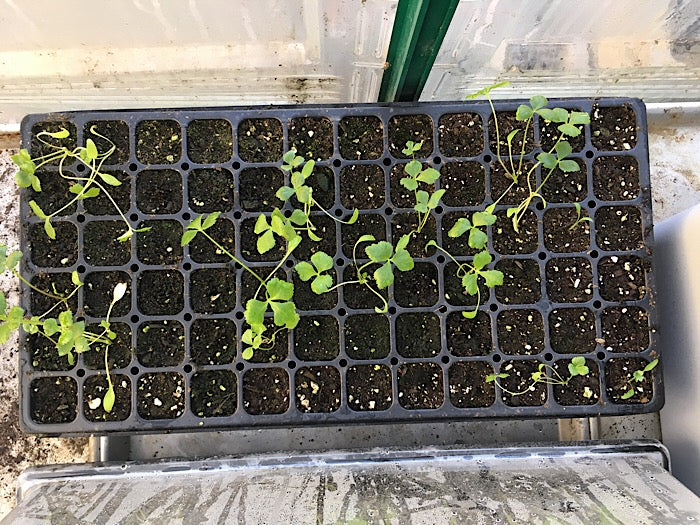
Although fresh seeds will germinate a lot easier than old, Ashitaba still has a much lower germination rate compared to other vegetables (see photo). They also take much longer to germinate. Mine took about 3-4 weeks, so be patient! Tip! Seeds sprout better in a high humidity environment so use a dome, or something to cover the growing area to keep the air moist. This is extremely important for dessert growers.
Ashitaba prefers to grow in rich organic matter such as compost, worm castings, ocean matters, bio char, rock dust. Keep soil moist, but well drained. You can add perlite to create light, fluffy potting soil if you are making your own.
In Southern California, the sun is strong so it’s best to grow them in part shade. If grown in cooler climate, it can tolerate full sun. However, it’s always best to slowly introduce the plant from full shade to full sun to prevent the leaves from burning or causing shock to the plant.
Watch Baby Ashitaba Grow!
WEEK 1-4 SEED GERMINATION
WEEK 5-8 FIRST SET OF TRUE LEAVES DEVELOPED
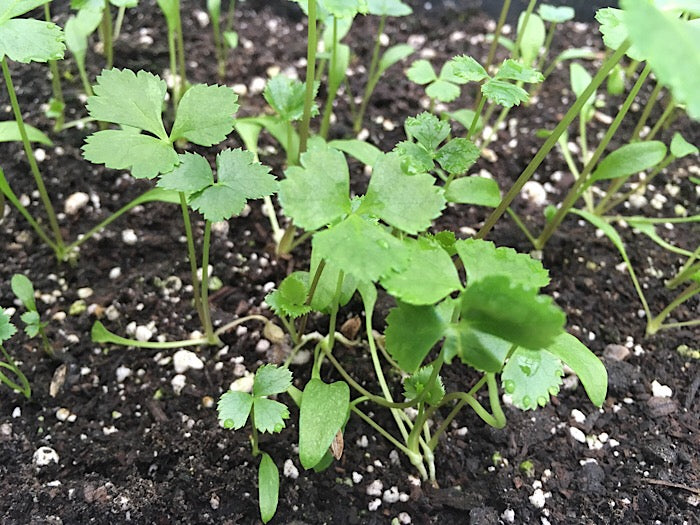
WEEK 9-11 FIRST TRANSPLANT TO SMALL POTS
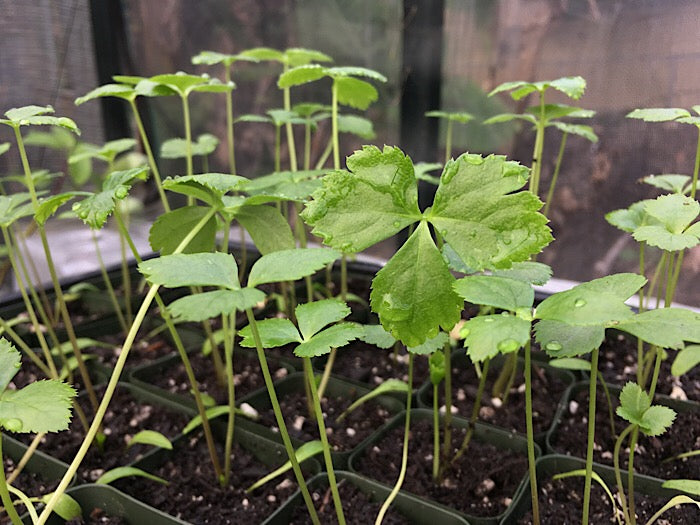
WEEK 12-15 PLANTS ESTABLISHING, DEVELOPING STRONG ROOTS
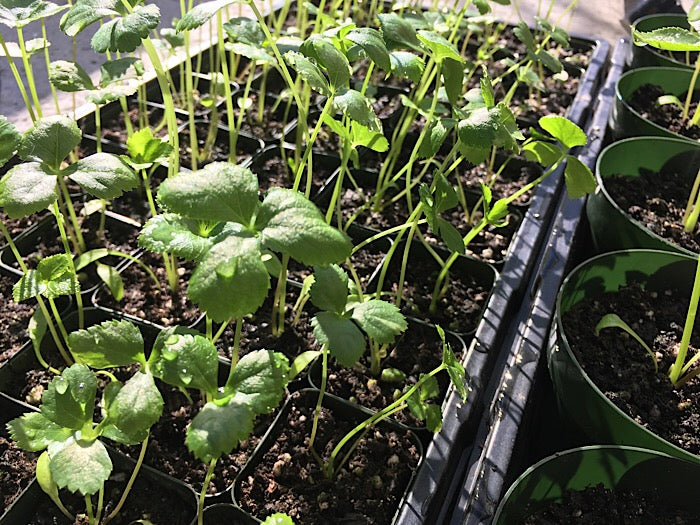
WEEK 16-24 TRANSPLANT TO NEXT SIZE POT, HARDENING, ESTABLISHING ROOT SYSTEM
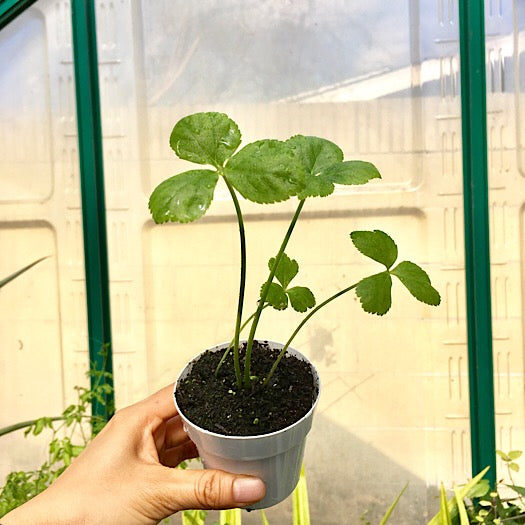
Why Grow Ashitaba? February 28 2018
 Ashitaba ( Angelica keiskei koidzumi ) is regarded as one of the most nutritious leafy greens or medicinal herbs. This wild food belonging to the Apiaceae (carrot) family is native to Hachijo Island of Japan. There are other plants that are mislabeled as Ashitaba. If you want to know which is the true Ashitaba, you’ve come to the right place!
Ashitaba ( Angelica keiskei koidzumi ) is regarded as one of the most nutritious leafy greens or medicinal herbs. This wild food belonging to the Apiaceae (carrot) family is native to Hachijo Island of Japan. There are other plants that are mislabeled as Ashitaba. If you want to know which is the true Ashitaba, you’ve come to the right place! One of the vegetables that is most commonly referred to as Ashitaba is the Gynura procumbens (Longevity Spinach). Although it is mistakenly referred to as Ashitaba, this plant does offer its unique health benefits such as for blood sugar and cholesterol health. Every type of plant offered a set of unique properties that benefit our health so I always encourage you to rotate your diet to get the maximum nutritional benefits.
One of the vegetables that is most commonly referred to as Ashitaba is the Gynura procumbens (Longevity Spinach). Although it is mistakenly referred to as Ashitaba, this plant does offer its unique health benefits such as for blood sugar and cholesterol health. Every type of plant offered a set of unique properties that benefit our health so I always encourage you to rotate your diet to get the maximum nutritional benefits. >> If you are in fact looking for Gynura procumbens, plants are available here.
What Does a Real Ashitaba Look Like?

The true Ashitaba AKA Tomorrow’s Leaf grows similar to the structure of a celery plant. Although I don’t find that a new leaf or steam would grow at the very next day after a stem is cut away, but the new stem does grow out very quickly, usually within the week. I believe the name Tomorrow’s Leaf can also symbolize that this plant brings hope and eternal life to one who eats it so to speak.
When the Ashitaba matures, it will bleed bright yellow sap known as Chalcone when the stem is cut. Chalcone helps to purify blood, boost immunity, benefits cholesterol health, blood pressure health, contains anti-cancer and anti-aging, antioxidant properties.
The entire plant is unique in the plant world due to its vitamin B12, which is usually not found in plant based food. This plant contains vitamin A, B vitamins, vitamin C, E, Biotin, Carotene, Calcium, Iron, Manganese, Potassium, Protein, Pantothenic Acid.
>> Watch the baby Ashitaba grow, click here!
>> Want to start growing your own Ashitaba? See here!
Fermented Foods January 23 2018
 Fermenting food is an old method used for preserving the plentiful harvest in the fall so there is enough to last through winter when no other crops can grow. When it comes to food preservation, fermenting provides the most health benefits. It is a living food, it is raw, and it is highly charged with nutrients in a jar all waiting to be enjoyed.
Fermenting food is an old method used for preserving the plentiful harvest in the fall so there is enough to last through winter when no other crops can grow. When it comes to food preservation, fermenting provides the most health benefits. It is a living food, it is raw, and it is highly charged with nutrients in a jar all waiting to be enjoyed.
Perks for Eating Fermented Foods
When you allow food to naturally ferment, the good bacteria in the vegetables becomes available to feed your gut, and the enzymes stay alive to help improve your digestion. Not only that, but your body will get to enjoy lots of other health benefits such as the B vitamins, vitamin K2, and probiotics.
B vitamins are essential for brain and heart health. This group of vitamins also help fuel your body, giving you more energy.
Vitamin K2 is essential for building strong bones, yes you need more than just calcium to build strong bones! Vitamin K2 can help lower risk of cancers, heart disease, and preventing blood clots.
Research estimates about 80% of your immune system is in your gut. What keeps your gut healthy are the probiotics (good bacteria). Probiotics also can help detoxify, draw out heavy metals in our body. Detoxing is what we city folks especially need since there’s so much pollutants all around.
Learn How To Make Fermented Foods!
If you never had fermented food, or you do not eat it regularly, start with a low dose, 1-2 table spoons with you meal. Some complaints from friends who are just starting to incorporate this as a lifestyle said it gives them diarrhea. Diarrhea seems to have a bad reputation, but in this case, it is likely that someone is experiencing this because the body is detoxing. When our body finds that something is not needed, it finds its way to release. Thus, fermented food is like a tool to aid this process of removing the bad things out of the body. That’s why it’s better to start eating small quantity if you are newly introducing yourself to it.
How to use fermented foods
Fermented foods is something to have as a side dish, or mixing in with other foods. Fermented foods add a distinctive, but pleasant taste to my meals. For some people — it may take a few tries to acquire the taste, but once you do, you will get to enjoy the benefits it offers.
Making fermented food as a side dish is convenient, but when you experiment adding it in your main dishes, it really lights up the flavor in your plate! Here are some ways I love pairing fermented foods with:
Try to mix a couple table spoons of fermented food with some suggestions below! Don’t add too much as it can overpower your dishes.
Mashed potatoes, salads, tacos, burritos, dippings for chips, Mexican soups (fermented vegetables placed on top to serve), Minestrone soup, and simple Asian stir fry!
Some combinations I fell in love with
After you master fermenting simple ingredients like cabbage or cabbage with garlic, you can start playing with different combinations.
Some websites suggest 1 tablespoon of salt with a cup of water, but I use 1.5 teaspoon of sea salt per cup of water as a brine for the combinations below. Sometimes I replace water with celery juice.
Rainbow carrots, onion, Jalapeño
Chinese Mustard greens
Carrot, Burdock, hot pepper (optional)
Cabbage, garlic
Napa cabbage, garlic
Bitter gourd
Cucumber, Dill
Grape leaves, Thyme
Cauliflower, carrot, garlic, pepper (hot or sweet)
Beet, carrot, cabbage, apple, garlic, peppers (sweet or hot)
Fermented Food For Furry Friends
In my home, even my furry child gets to enjoy fermented food. She loves fermented cabbage with garlic, carrots, and cauliflower. She weights 62 lbs so I add 1-2 table spoons in her food. She too can benefit from fermented food just like us!
When making for my dog, I use 1 teaspoon of sea salt with 1 cup of water. Water can be replaced with celery juice or pear juice.
Cabbage (purple or regular), garlic
Asparagus, cabbage, dandelion
Beet, carrot (rainbow), cauliflower, garlic, burdock
How long does it take to ferment food?
Food ferment faster when it’s warm, and slower when it’s cold. Therefore, the temperature of the room you are fermenting in will affect the speed of the fermentation. Normally it takes 5-7 days for food to be ready to eat, but I have fermented things for up to 2 weeks until I decided to move it to the refrigerator.
Firm vegetables and large vegetables will take longer to ferment than soft vegetables or shredded vegetables. Carrots, beets, burdock, sweet potatoes , cauliflower will take longer to ferment than cabbage, mustard greens, kale, or peppers.
Don’t throw the fermented food juice away!
Did you know that there are venders at the farmers market selling fermented juice? This is the liquid from the fermented vegetables, just like the liquid in the jar you make! So why not save yours too?
I love adding the juice in any dipping sauces, salad dressings, flavor my soups. Don’t add it in super hot dishes, wait till it cools a bit or you end up killing the good bacteria in the fermented liquid.
If you grow a garden — small of large — your plants can benefit from the probiotics too! I love diluting fermented juice in filtered water to nourish my plants. I dilute it until you can barely taste the salt in the water.
When should you dispose the jar of fermented food?
Out of the many times I have been fermenting, it’s very rare do I have to throw the entire jar away. When that happened, I learned that it is because I did not have all the vegetables completely submerged in the liquid. Once I corrected this, it was no longer a problem. Mold grows when there is oxygen so keeping food under water will avoid this issue. Make sure to use rocks, or a large piece of cabbage to keep everything under water.
If the vegetables float to the top when gas is building inside, open the jar and push the vegetables down then close the lid. You can do that when you check on the jar daily.
*Bonus tips!*
Since you’ve made it all the way here to my blog, I’ll let you in a few secrets!
Tip 1
If you do not use air conditioning at home, your vegetables will ferment faster in the summer; however, I find that a slow fermenting process taste best. In that case, I like to keep mine in a cooler indoor. If you don’t have one, just keep it in a cool place such as the kitchen cub board. Make sure to put a tray under the jars in case of any spills.
Tip 2
Did you know that you can ferment vegetables in the refrigerator? The cold slows down the fermentation. This means you can do the entire fermentation process inside of a refrigerator, except it would take much longer for it to be ready.
Tip 3
When the vegetables are fermenting, the gas built-up inside makes the smell get stronger. When I have garlic in the jar, it can make the cub board smell like garlic. I do have a sensitive nose so maybe others may not smell it! Anyway, if you want to avoid the smell in the cub board, it’s best to invest in a cooler, even an old beat up one would work.
Tip 4
Food will ferment as long as it is completely submerged in water. Technically, salt is not needed for fermenting, but it does improve the taste, and keep the vegetables crunchy for a longer period.
Living foods can bring longevity to your health, but the living food itself does not last forever. It takes a very long time for fermented food to become no longer palatable, if stored in the refrigerator, but the maximum nutrition you can benefit from is during the first 6 months of when it is made.
I hope this post is thorough enough to give you the confidence to start making your own. Much love and happiness to you!
My Top 5 Favorites To Grow 2017 January 09 2018
There’s a few greens that grows year round here in Southern California. It’s not a coincidence, these two happens to be my top 3 favorite leafy greens: Gynura procumbens AKA Longevity Spinach, Ashitaba, and a variety of Kale.
Aside from the greens just mentioned, I like growing different crops each year to keep things exciting and diverse in our diet. This is especially a good idea when you are growing in limited space. Below are my top 5 favorites grown last year. Since I incorporated these food in different dishes and use them for different health reasons, I will not be labeling which plant is more significant to me than others.
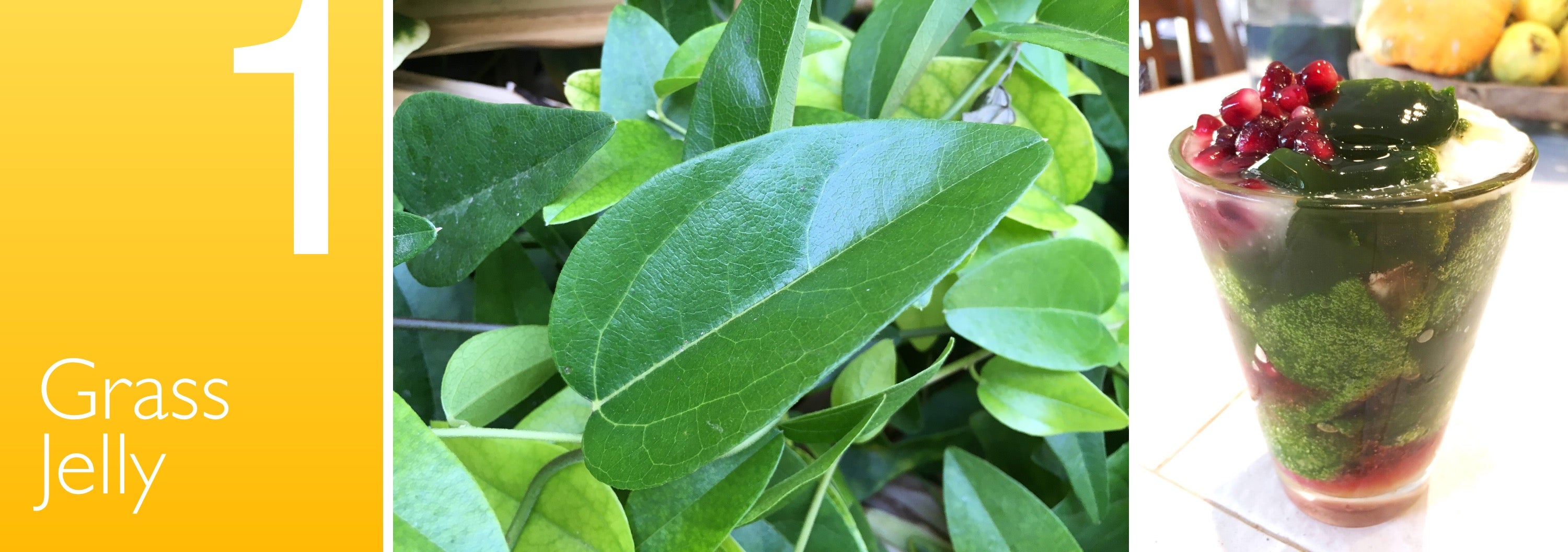
Though I had been growing Grass Jelly (Cocculus orbiculatus) for years now, but last year was when I made use of the plant the most frequent. I’ve always made “jello” with the leaves of this vine and paired it with chia seeds, edible flowers, honey, berries or other fruits. It wasn’t until last year when I thought of pairing it with coconut cream, pomegranates and honey. Since then it’s been my favorite way of eating “jello”. I made this a couple times a week throughout our pomegranate season.
Bitter Melon
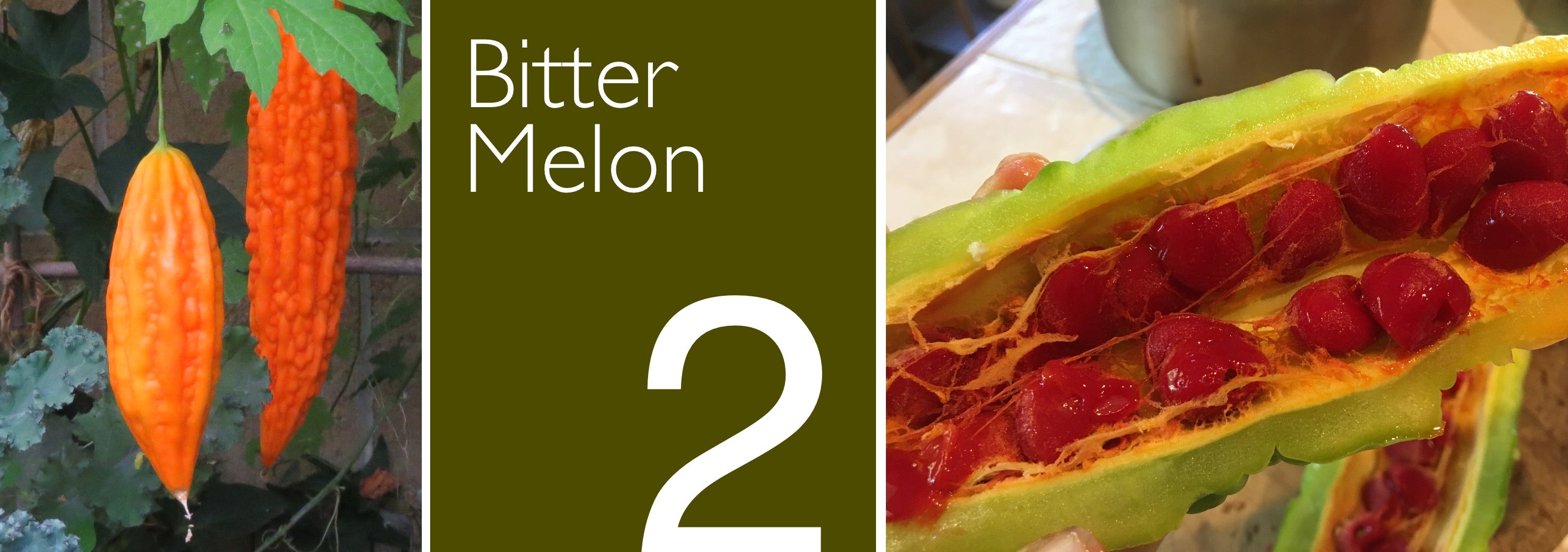
Although the taste of bitter is not for everyone, but I’ve always loved this vegetable. To me it’s the bits of bitter in my savory food that makes it taste even better! Last year was exciting for me because I figured out how to grow this vine with much more success in my very conservative watering garden. Once these vines started to take off, I had enough to harvest for cooking weekly. I fermented them, made stir fried with eggs, soups, stuffed Bitter Melons.
Sabah Snake Grass

There’s articles of studies and personal experiences from patients who used this herb to aid their kidneys or fight cancers. Do your own research and you will be amazed by the information available! As for me, I am all about eating foods that have the ability to prevent or combat varies diseases. However, if you want to try something new, I will remind you to only try what you are absolutely comfortable with, and have researched about of course. As for me and my family, including my dog, we have a few raw leaves or add them in smoothies once or few times weekly.
Most people I know are not a fan of the taste of leafy greens. That’s makes Sabah Snake Grass special because it does not have a strong flavor like kale or collard greens. It’s a medicinal herb so it’s not something to eat in large volume like a salad unless it’s a in a protocol for treatment of healthy conditions, which you have thoroughly researched and discussed with a medical professional.
Pumpkin
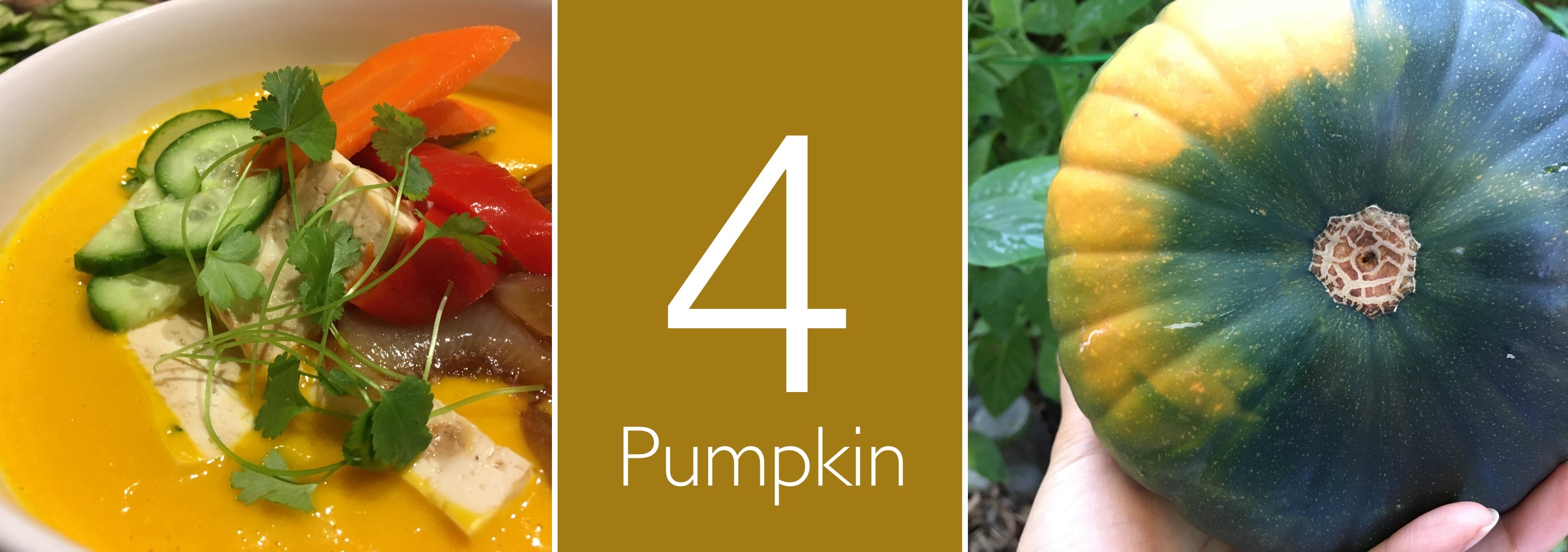
Somehow there were a couple of volunteer pumpkins that sprouted and started taking over the front garden. Though I couldn’t identify the variety, this pumpkin does have flavor closest to a Japanese pumpkin like a Kabocha. It was a productive crop that produced pumpkins that were ready for harvest within 2-3 weeks after flowering. I enjoyed the taste of these pumpkins throughout the different stages of maturity.
Pumpkin is cooked on a regular basis in my home. It’s a healthier choice of starch that keeps us full and satisfied. Since I make grain-free, low carbohydrate food for my dog, pumpkin became the very ingredient that keeps her tummy satisfied as well. I also enjoyed making pumpkin soups, stir frys, and casseroles with these pumpkins.
Galangal

This is a type of ginger is believed to be originated form southern China, but it is commonly used in Thai cuisine. Galangal has a strong but inviting aroma that tastes like pepper and ginger combined. In Thailand it’s called Krachaai, and this herb is what gives Thai cuisine the distinctive taste. I add this root herb in Tom Yum Soup along with Lemon Grass and Kaffir Lime leaves. Flowers of this plant is pleasantly fragrant. Just a few in bloom was enough to make the side garden smell like perfume.
John Kohler From Growing Your Greens Visiting Wendiland October 13 2017
John Kohler is the host of the most popular gardening channel on Youtube called Growing Your Greens (GYG). He has over 640K subscribers, and over thousands of videos teaching various methods on growing your own food.
John is one of the most genuine and down-to-earth friend you can come across. We met each other at the National Heirloom Festival in Santa Rosa, California. It was such a pleasant surprise when he showed up to my presentation — he wanted to explore more about Asian vegetables. >Read my blog about the National Heirloom Festival.
A couple months later John came to visit, and we ended up talking for hours. Soon enough, the sun was starting to set so we had to cut the conversation short so he could start filming the video before losing daylight!
John was intrigued to learn about the health benefits of the herbs here. His reactions to trying certain in the garden for the first time was just priceless. He even tried the fully raw vegan plant based “jello” I made! Don’t miss this video, and see the interview we had too!
Healthiest & Easiest Asian Vegetables You Should Grow
Plants Featured In This Video:
Purple Sweet Potatoes 0:06:19
Pumpkin 0:08:30
Holy Basil AKA Tulsi 0:11:13
Milk Weed 0:15:40
Bitter Leaf 0:18:07
Gotu Kola 0:20:29
Okinawa Spinach 0:22:07
Gynura procumbens 0:25:10 and 0:32:29
Grass Jelly 0:25:30 and 0:27:11
Sabah Snake Grass 0:28:27
Wild Betal (Piper) 0:29:23
Galangal ginger 0:33:51
Immortality Herb (Jiao Gu Lan) 0:35:13
Leaf of Life 0:35:21
Perilla AKA Shiso 0:36:39
Fish Mint (Chameleon plant) 0:37:00
Vietnamese Corinader (rau ram) 0:37:32
Ashitaba 0:40:02
Interview With Wendi
0:43:42 How did you get into growing all this stuff?
0:44:30 What is your relationship with some of the vegetables in this episode?
0:45:00 Were these Asian vegetables eaten for their flavor or health benefits?
0:45:25 What kind of health benefits have you experienced from these Asian vegetables?
0:47:00 What are some Asian greens for cold and flu?
0:47:47 Why did you start making YouTube videos?
0:50:38 What are favorite 5 Asian vegetables?
0:50:55 Sabah Snake Grass
0:52:57 Bitter Leaf Tree
0:54:33 Rice Patty Herb
0:55:23 How you can easily get some of these plants?
0:56:36 Pandan Herb
0:57:20 Grass Jelly Vine
1:00:55 Gynura Procumbens AKA Longevity Spinach
1:02:27 What are the health benefits of Gynura Procumbens?
1:03:21 Why did you start making Gynura Procumbens available for others?
1:05:25 How can you grow tropical plants year round?
1:07:30 What are your growing practices? How do you grow? What fertilizer do you use?
1:08:36 What is a Marimo?
1:10:30 Do you eat the Marimo algae balls?
1:13:20 Any final words of wisdom for my viewers?
1:15:21 How can viewers learn more about you?
John is an extremely knowledgeable gardener, and a wonderful person. He has 3 YouTube channels to educate his viewers. Go checkout his videos and subscribe!
Gardening, Growing your food
Youtube.com/growingyourgreens
Tips & Tricks to a raw diet
Youtube.com/OKraw
Extensive comparisons on health food applicances
Youtube.com/discountjuicers
Yin Yang Through Plants September 17 2017
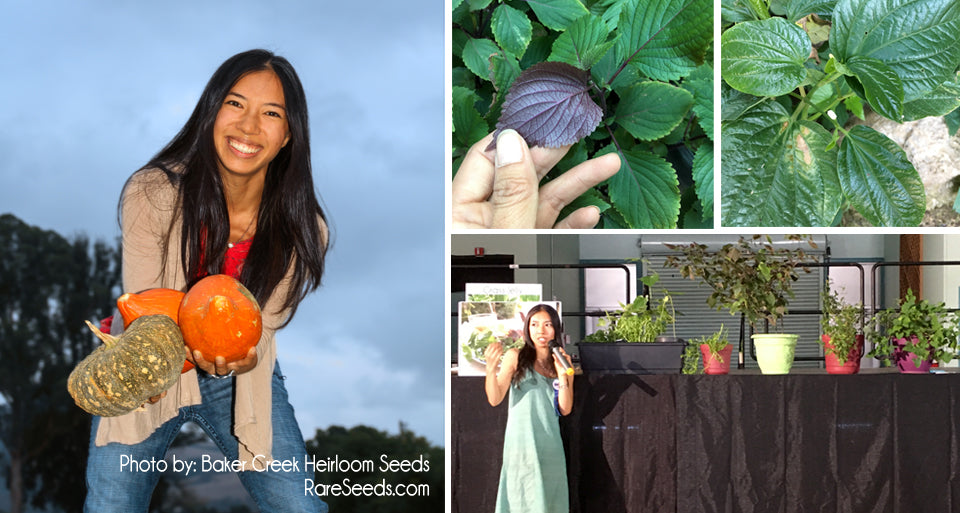
"The National Heirloom Expo showcases the world's largest show of pure food diversity!" I feel so honored to be invited to speak at this exciting event. In order to allow the audiences to fully experience the Asian herbs that were in my presentation, I decided an 8+ hour roadtrip to Petluma, CA was necessary to get the plants there safely. At the end of the talk, everyone was welcomed to taste and experience all the edible plants I brought.
For those of you that missed my talk, here's what I've covered in my presentation:
In Traditional Chinese Medicine, the philosophy of Yin and Yang is used to balance the body.
Yin: represents shade, cooling, calming nature
Yang: represents the sun, heat, aggressive nature
Vietnamese balance their food using the five fundamental tastes:
Sweet, salty, sour, spicy and bitter
These 5 tastes correlates with the 5 elements which represents the organs in the body:
Metal: spicy flavor benefiting the nose, lung, large intestine
Wood: sour flavor benefiting the liver, eye, gall bladder, veins
Water: salty flavor benefiting the ear, kidney, urinary, bladder
Fire: bitter flavor benefiting the tongue, small intestine, blood, heart
Earth: sweet flavor benefiting the mouth, stomach, muscle
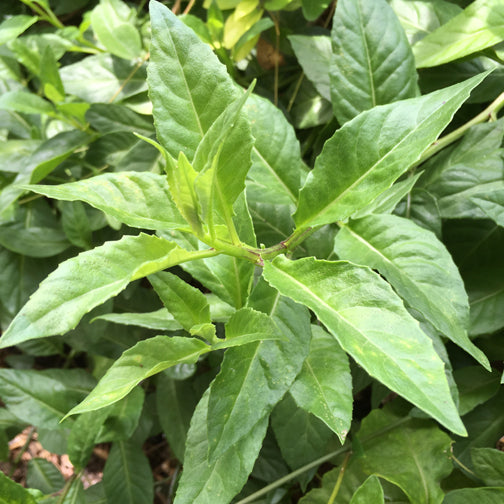 |
Gynura procumbens Other name: Longevity Spinach Nature: cool Origin: SE Asia, Thailand, Indonesia, West Africa Health benefits: promotes healthy range for blood pressure, blood sugar, and cholesterol. Contains amino acids, carotenoids, alkaloids. Promotes healthy weigh management, and healthy gut bacteria. Uses: leaves and tender stems are used in soups, salads, smoothies. |
 |
Vietnamese Coriander Other name: Rau Ram, hot mint, Pericaria odorata Nature: warm Origin: SE Asia, Cambodia, Vietnam, Singapore, Malaysia, Laos, Thailand Health benefits: helps bones and bruises, lowers sex hormones, improve digestive issues such as diarrhea, stomach ache. Contains anti-inflammatory. Uses: raw leaves and tender stems are used in salad, soup, stir fry rice vermicelli. |
 |
Gotu kola Other name: Pennywort, Rau Ma, Herb of Wisdom Nature: cool Origin: Central Asia, parts of Africa, China, India, Vietnam Health benefits: benefits brain health, cognitive health, rejuvenating, includes wide range of vitamins and minerals, improve concentration, Benefits the nervous system, calming, manage anxiety, stress. Uses: raw leaves are used for juicing, leaves cooked in soups, leaves added to salads. |
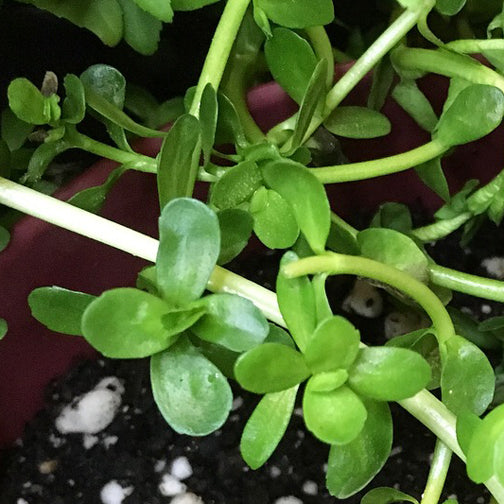 |
Bacopa Other name: Bacopa monnieri, Rau Dang Bien Nature: cool Origin: wetlands of Africa, SE Asia, Australia Health benefits: benefits mental functioning, memory, comprehension. Contains Bacosides properties, a powerful antioxidant in brain, improve nerve conduction, help to improve cognitive function. Uses: raw leaves are eaten raw, cooked in soup, add to salad. |
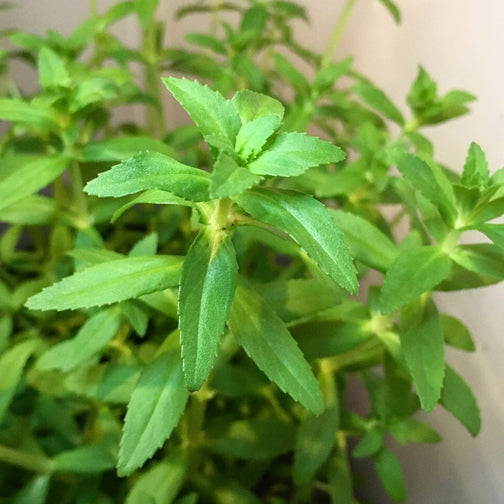 |
Rice Paddy Herb Other name: Rau Om, Hugging herb, Limnophila aromatic Nature: cool Origin: Vietnam, SE Asia, Malay, Indonesia, China, Cambodia, India Health benefits: benefits brain health, cognitive health, rejuvenating, includes wide range of vitamins and minerals, improve concentration, Benefits the nervous system, calming, manage anxiety, stress. Promotes fever relief, appetite stimulant, fever relief, appetite stimulant, antiseptic, regulate female hormone indigestion Uses: raw leaves are used for juicing, leaves cooked in soups, leaves added to salads. |
 |
Perilla Other name: Tia To, Perilla frutescens, Shiso, purple mint Nature: warm Belongs to mint family Origin: China, India, Japan, Korea, Thailand, Vietnam Health benefits: relieves vomit and diarrhea from minor seafood poisoning, improves digestion, contains omega 3. Uses: leaves are used with ginger in a decoction for minor seafood poisoning. |
 |
Grass Jelly Other name: Suong Sam, Cocculus orbiculatus Nature: cool Origin: SE Asia, Vietnam, Indonesia Health benefits: promotes healthy range for blood pressure, blood sugar, and cholesterol, relieves fever discomfort. Pectin soothes GI tract, slows glucose absorption. Contains high amount of water soluble fiber, and chlorophyll. Uses: leaves are mashed, massaged and strained to extract juice. |
 |
Fish Mint Other name: Diep Ca, Houttuynia Cordata, poison blocking plant Nature: cool Origin: China, Japan, Korea, Vietnam, India Health benefits: anti-bacterial, anti-viral, anti-inflammatory, benefits respiratory, reduce coughs. Uses: leaves and tender stems are eaten raw. |
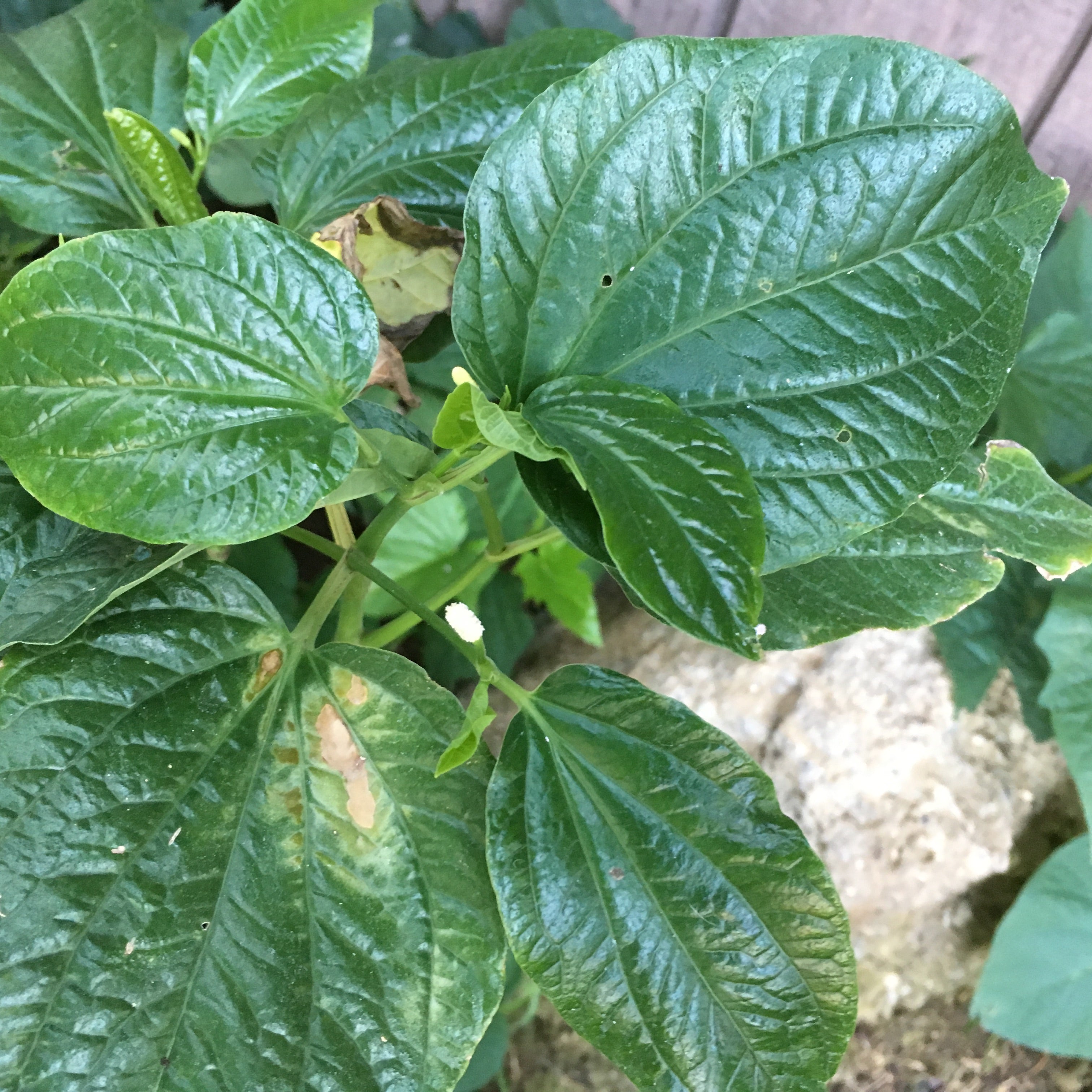 |
Wild Betal Other name: La Lot, Piper Sarmentosum Nature: warm Belongs to peppercorn family Origin: Malaysia, Vietnam, Lao, India Health benefits: helps speed fractured bone injury, joint aches, has anti-depressant effect. Contains powerful antioxidant called Naringenin. Uses: use as wrap to grill, cook leaves as a decoction. |
Super Power of Lemon June 21 2017
 All fruits and vegetables have different super powers. Today I will turn the spot light on the lemon. Here's why! In the previous post, I had shared information about vegetables containing different amounts of oxalate. Oxalate is a natural compound found in plants. When there's a high amount of oxalate in the body, it can bind with calcium, forming crystals and eventually become kidney stones. This is an unbearable pain that calls for an emergency visit for medical attention.
All fruits and vegetables have different super powers. Today I will turn the spot light on the lemon. Here's why! In the previous post, I had shared information about vegetables containing different amounts of oxalate. Oxalate is a natural compound found in plants. When there's a high amount of oxalate in the body, it can bind with calcium, forming crystals and eventually become kidney stones. This is an unbearable pain that calls for an emergency visit for medical attention.
Lemon has the superpower to prevent kidney stone formation. The citrate in lemon juice can dissolve crystals when they begin taking form. Below are tips that will help you in preventing oxalate build up in your body and stay hydrated all summer long!
Ways To Prevent Kidney Stones
- Add lemon juice in any recipes containing high oxalate
- Oxalate in foods can be reduced by the process of steaming or cooking
- Add juice of 1/2-1 lemon in water to drink daily
- Make vitamin water by adding any fruits you like submerged in water with some lemon juice
- Rinse mouth after drinking or eating any citrus to protect enamel
- Eat foods with high oxalate with caution, see list of foods here
Ways To Keep Your Kidneys Happy
- Stay hydrated through the day
- Eat food full of moisture to protect your kidneys
- Low sodium diet puts less stress on kidneys
- Eat whole foods, unprocessed foods
- Best to avoid soda and alcohol, or at least drink as few as possible
- If you struggle with Diabetes, consult with your medical physician about kidney health
Benefits of Growing A Lemon Tree
Lemon is one of the easier citrus to grow. Places with a wild winter can be grown outdoor, but it grows well in containers too! You can always bring it indoor over winter if it's kept in a pot. In zone 9 and 10 lemons and limes are hanging on the tree almost year round.
The use of lemon is so versatile that you don't have to worry there's too many! It's a flavorful, functional fruit to have around the house. You can make lemonade, lemon powder, lemon zest for cooking and baking, add a small amount for DIY skincare to brighten skin, and even to make disinfecting cleaning product. If there's still lemons any left, juicing and store in freezer will keep them fresh for the next time you need them.
Vegetables that Should Be Eaten With Caution June 18 2017
 Summer just arrived! For some home gardeners this is the prime time to enjoy our harvests. When it comes to growing greens, Spinach and Swiss Chard remain being the popular choices of greens to grow. Spinach contain a range of nutrients such as iron, niacin, calcium, phosphorus, copper, vitamins A, C, E, K and lots more. It also has a very mild flavor so it's great to hide in smoothies.
Summer just arrived! For some home gardeners this is the prime time to enjoy our harvests. When it comes to growing greens, Spinach and Swiss Chard remain being the popular choices of greens to grow. Spinach contain a range of nutrients such as iron, niacin, calcium, phosphorus, copper, vitamins A, C, E, K and lots more. It also has a very mild flavor so it's great to hide in smoothies.
Swiss Chard come in colors of the rainbow. The stalks and veins of these plants come in vibrant red, pink, yellow, orange and white -- these truly brighten an edible garden on any day! Besides the beautiful appearance, these vegetables also offer properties such as calcium, manganese, iron, potassium, B vitamins, vitamin C, anti-inflammatory and antioxidant benefits.
Both of these vegetables are great for our health, but there's one thing you should be cautious of if you like consuming them on a regular basis. Spinach and Swiss Chard contain higher amounts of oxalate than some other plants. Oxalate, AKA Oxalic Acid, is a natural compound found in plants, and can bind with calcium in the kidneys when ingested. When there's too high amount of oxalate accumulated, it can cause kidney stone formation. Below is a list of foods that you can use to reference the next time preparing a meal.
Foods With High Oxalate
- Spinach
- Swiss Chard
- Rhubarb
- nuts
- beet root, and beet leaves
- avocado
- taro root
- dates
- beans
- kiwi
- figs
- wheat
- potato
- sweet potato
Foods With Low Oxalate
- Kale
- Cabbage
- Cauliflower
- Cucumber
- Bok Choy
- kohlrabi
- mushrooms
- radish
- water chestnuts
- peas
For those who have a history of kidney stones, or urinary tract stones is best to avoid consuming foods that are high in oxalate, especially should not be consuming them on a regular basis. Speak to your medical physician or nutritionist about being on a low oxalate diet to prevent recurrence.
Gynura procumbens is a delicious replacement for Spinach. It has a similar texture and taste to Spinach, especially when cooked. This vegetable also offers lots of health benefits especially for blood sugar and cholesterol health. For more information on growing this vegetable, see this article.
Find out how to easily prevent kidney stones in this article.
Eco Garden Expo Day June 08 2017
 It was a gloomy morning, and a storm might be on its way said the weather app. Despite the rain might pour, the show must go on! I was invited to speak at the event so there was lots of space crowding props such as large plants to load before heading out. Also, I was giving away an olive pickling barrel. That alone took up half the space in the SUV! As my helper and I were filling up the vehicle, I felt sprinkles began to hit my face. The SUV was completely full by then, and I sure hoped someone will turn up.
It was a gloomy morning, and a storm might be on its way said the weather app. Despite the rain might pour, the show must go on! I was invited to speak at the event so there was lots of space crowding props such as large plants to load before heading out. Also, I was giving away an olive pickling barrel. That alone took up half the space in the SUV! As my helper and I were filling up the vehicle, I felt sprinkles began to hit my face. The SUV was completely full by then, and I sure hoped someone will turn up.
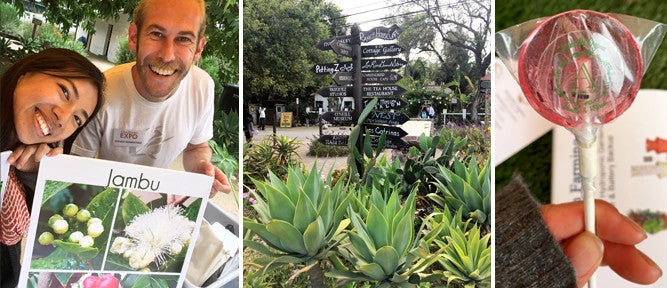 Fortunately, the drizzle had stopped when we arrived. I met with the coordinator, and he helped us unload so I could start setting up. When it was getting closer to my presentation, seats started to fill. The rain seems to drive people away from the outdoors usually, but...Oh my goodness! THANK YOU for coming everyone!
Fortunately, the drizzle had stopped when we arrived. I met with the coordinator, and he helped us unload so I could start setting up. When it was getting closer to my presentation, seats started to fill. The rain seems to drive people away from the outdoors usually, but...Oh my goodness! THANK YOU for coming everyone!
 I gave a talk on my personal experience in growing tropical, exotic plants & herbs in Southern California. Health benefits of these herbs seem to intrigue many, and the culinary aspect definitely had struck lots of curiosities.
I gave a talk on my personal experience in growing tropical, exotic plants & herbs in Southern California. Health benefits of these herbs seem to intrigue many, and the culinary aspect definitely had struck lots of curiosities.
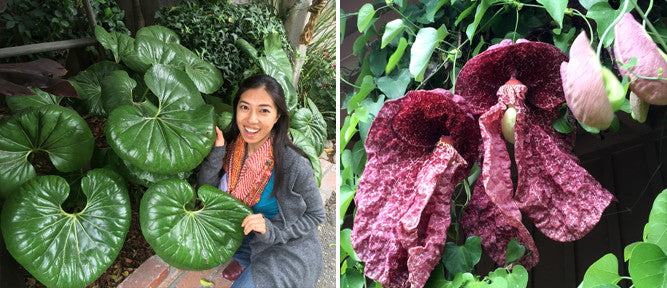 After the talk, we watched a couple of speakers' talks then went around exploring the the goods and the old shops behind the park. There were 20 great speakers eager to spread their knowledge all throughout the weekend, and 60+ vendors offering unique plants, plant based treats and garden supplies at the beautiful park in the historic district of San Juan Capistrano, CA.
After the talk, we watched a couple of speakers' talks then went around exploring the the goods and the old shops behind the park. There were 20 great speakers eager to spread their knowledge all throughout the weekend, and 60+ vendors offering unique plants, plant based treats and garden supplies at the beautiful park in the historic district of San Juan Capistrano, CA.
If you are in the area, next April, don't miss out on this if you are looking for ways to improve your growing success! The event was held by Goin Native. They offer workshops locally throughout the year to help people and plants thrive together. Be sure to checkout their website for more information.
Thank You Benafsha, Steven, and everyone at Goin Native for everything, and for such a fun day!
Identifying Your Gynura Procumbens May 18 2017
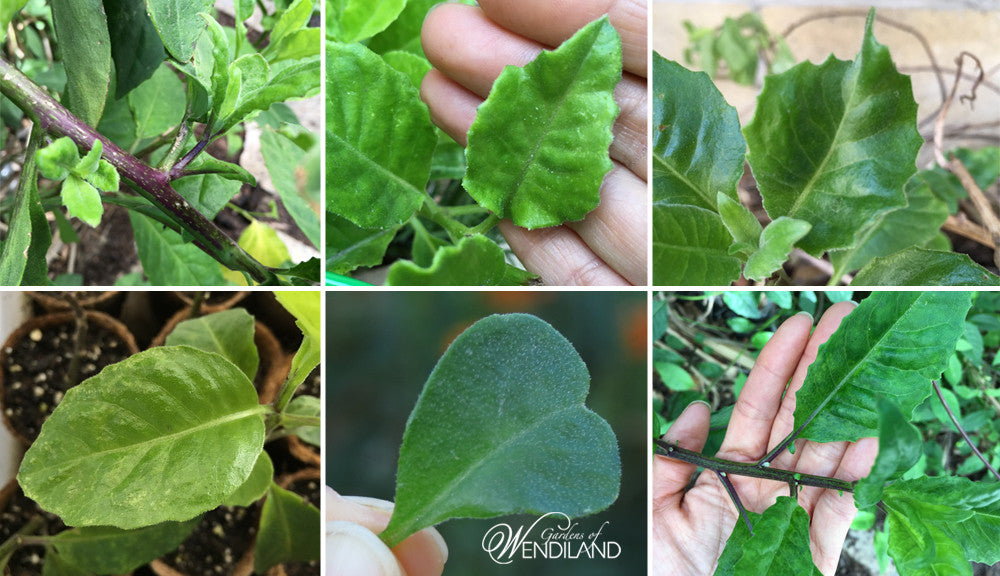
Leaves of the Gynura procumbens can take on many organic shapes. If you are unfamiliar with this vegetable, sometimes it can keep you guessing whether that plant you have is in fact a Gynura procumbens. Below are a few key things I have highlighted to help you understand why your Gynura procumbens may look the way they do.
Growing in Full Sun
Normally when growing Gynura procumbens in full sun, the leaves take on thicker, more crisper succulent texture. At times the leaves can develop ruffle edges, or more defined serrated edges. The green stems can develop purple specks, and the midrib of the leaf can become purple. Thus, some home growers became confused between Gynura procumbens with another vegetable: Gynura crepioides.
Growing in Part Sun or Full Shade
Gynura procumbens is mainly green in color when growing in most shaded area. The leaves are thinner, more flexible compared to being exposed to more intense sun. With inefficient light, the leaves can grow smaller, and the stems would stretch. This means each leaf would grow further apart from each one along the stem.
Hope you find these tips to be helpful! If you are still uncertain whether you are growing Gynura procumbens, it's best to check with a source that you trust. Happy Gardening!
♥Enjoy this video as I documented Gynura procumbens growing throughout the four seasons in Southern California♥
Easy Way To Get Your Plants Growing Stronger March 17 2017
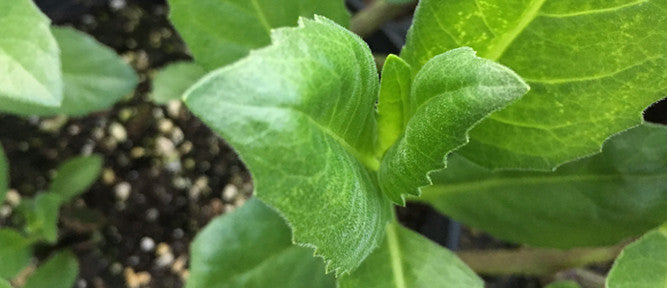 Spring has sprung in Southern California, but for some of you -- don't worry, spring is almost here! Now it's time to prepare for your growing season.
Spring has sprung in Southern California, but for some of you -- don't worry, spring is almost here! Now it's time to prepare for your growing season.
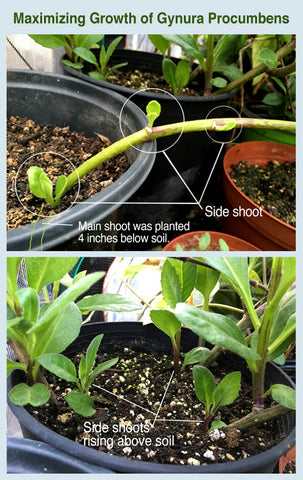 To maximize the growth and production of your plants, you want to grow them in rich, fluffy, organic soil that consist of compost, worm casting, peat moss or coconut coir, and perlite. However, for plants that root easily once they touch the soil, you can take an extra step to get your plants growing fuller and stronger. Plants that root easily such as basil, tomato, Gynura procumbens, potato and mint can be planted deeper to build a stronger and larger root system. Normally we allow the soil level to cover up to an inch above the start of the roots, but for plants that root easily can be planted up to the next node on the shoot. They can even be planted horizontally laying on the ground too! The side shoots will rise above the soil growing strong and full. This is especially beneficial for growing leafy greens as there will be more leaves to harvest. Try it next time you plant!
To maximize the growth and production of your plants, you want to grow them in rich, fluffy, organic soil that consist of compost, worm casting, peat moss or coconut coir, and perlite. However, for plants that root easily once they touch the soil, you can take an extra step to get your plants growing fuller and stronger. Plants that root easily such as basil, tomato, Gynura procumbens, potato and mint can be planted deeper to build a stronger and larger root system. Normally we allow the soil level to cover up to an inch above the start of the roots, but for plants that root easily can be planted up to the next node on the shoot. They can even be planted horizontally laying on the ground too! The side shoots will rise above the soil growing strong and full. This is especially beneficial for growing leafy greens as there will be more leaves to harvest. Try it next time you plant!
Why You Should Eat Sprouts September 07 2016

Sprouting is an excellent way to grow your own nutritious food in a short period. A tray of sprouts can be grown in just 1-2 weeks! It's a great choice for anyone, but particularly beneficial if you are limited to outdoor gardening during the colder months.
Sprouts are at least 10-30 times more nutrient dense than a full grown plant. During the sprouting stage, they contain a much higher content of enzymes, vitamins, essential fatty acid and fiber than fresh fruits and vegetables. These nutrients are also easier for our body to absorb during this stage.
My Favorite Seeds To Sprout
There's all kinds of seeds you can sprout, but my top favorites are sunflower seeds, mung beans, and Chia seeds. If seeds are fresh, they take just 2-5 days to sprout usually. The warmer the room is, the faster they begin sprouting. I enjoy sunflower sprouts and mung bean sprouts the most because of the nutty flavor, and crisp texture.
 How To Sprout In A Jar
How To Sprout In A Jar
I highly recommend beginners to start using this method since this is the easiest way to sprout. In the warmer months I particularly enjoy sprouting mung beans in a mason jar. The warmth of the room makes them sprout as quickly as one day! The fresher the seeds are, the faster they will sprout.
The entire process should only take 2-5 days usually. If the seeds take a week or longer to sprout, they are too old. Keep in mind not every seed will sprout either, but majority of them should.
Pick up a sprouting jar at any health food market, or home & kitchen shop. You'll need a glass jar with a mesh wire lid to allow air circulation.
Let's Begin!
1. Place a small hand full of seeds in the sprouting jar then fill it with drinking water. Let it soak overnight, and the seeds will expand at least 50% more than when they were dried.
2. By the next morning, drain and rinse the seeds then keep the jar in a bright, cool location (70-80F is ideal). Usually anywhere on the kitchen counter that does not get direct sunlight would be fine.
3. Rinsing helps to keep seeds clean, and prevents mold or fermentation occurring so each day rinse the seeds 1-2 times. In a warm room, rinse at least 2 times per day. Repeat this step until the sprouts grow to the length you like. I prefer anywhere between 1/2 - 1 inch.
4. When sprouts reach the length desired, they are ready to go on your dinner plate! Store the jar or transfer it to another container and keep in refrigerator. The cold will stop the sprouting process, and keep them fresh.
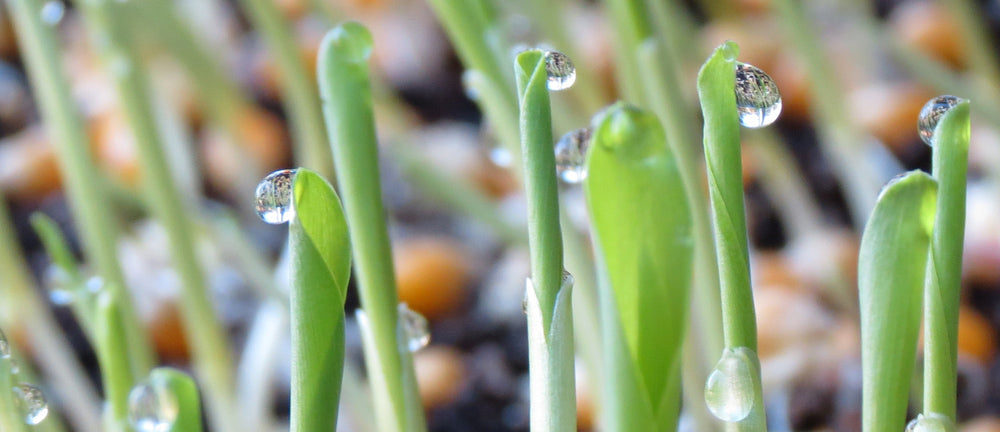
How To Grow Sprouts In Soil
I use a tray to grow sprouts in soil. This allows me to grow more sprouts than a jar. I can also get the sprouts to grow up to around 3 inches, or until the first true leaf begins to show on the sprout.
Sprouting in soil is great for sunflower seeds, kale, daikon radish, corn, peas, wheat grass and so much more! Normally sprouts grown in soil, or any kind of growing medium is called micro greens. These plants are just a tiny bit older than sprouts you grow in a jar. The entire process takes about 1-2 weeks depending on the seeds you choose.
You can use organic indoor potting soil, or coconut coir for the seeds to set roots in.
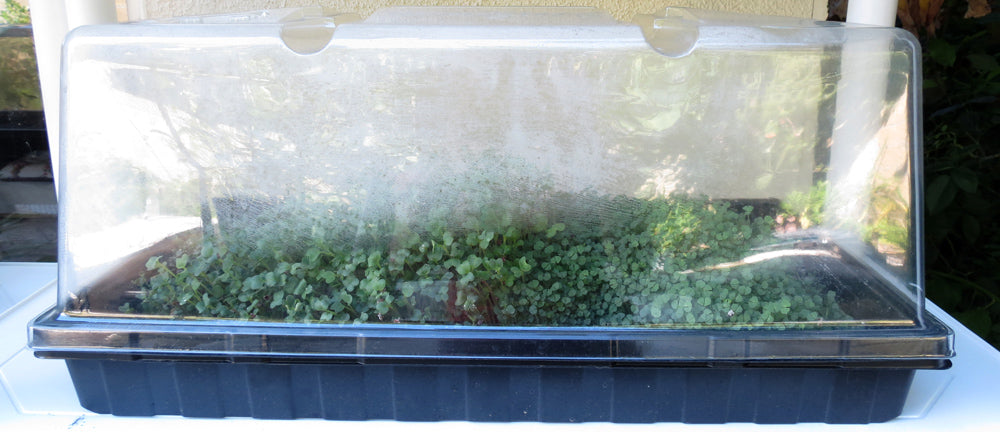 As for the tray, I highly suggest purchasing a seed growing tray at your local nursery, Orchard Supply Hardware, or hydroponic shop. For growing micro greens, you would need a 3 tray setup. These growing trays are very inexpensive, and make it much easier to grow abundance of food.
As for the tray, I highly suggest purchasing a seed growing tray at your local nursery, Orchard Supply Hardware, or hydroponic shop. For growing micro greens, you would need a 3 tray setup. These growing trays are very inexpensive, and make it much easier to grow abundance of food.
Why 3 trays would be ideal for growing micro greens: 1 tray has holes for drainage. The other 2 do not have holes. The tray with holes is the one seeds will be planted in, and this sits on top of the tray without holes so it can catch any excess water. The third tray will be used for covering the top to keep dark, and help retain humidity.
I prefer seed growing trays since it's shallow and wide, but you can use something as simple as a regular pot for plants since these have holes for drainage. You can also find any plastic containers and poke holes on the bottom, and use a baking tray to put underneath.
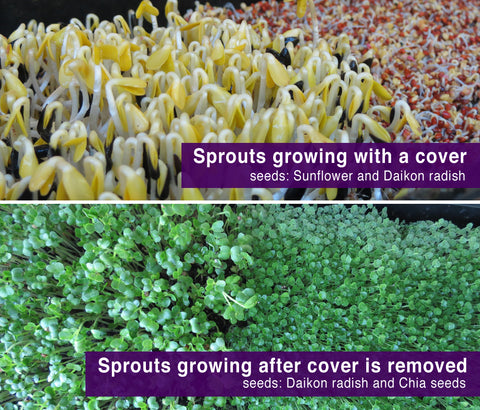 Let's Begin!
Let's Begin!
1. Place about 1/2 inch of then lay a thin layer of seeds closely together on the top.
2. Mist soil and seeds with a water spray bottle to moisten. Do not over water. Soil just needs to constantly stay damp. When finished, cover the top.
3. Keep tray in a cool location without direct sunlight.
4. Check on the tray daily, spray water when needed. You will start to see sprouts peeking through the soil in a few days.
5. Once the plants grow to about 2 inches, keep the tray uncovered and move it to a brighter location if needed. By uncovering it, you are encouraging chlorophyll to produce. This takes around 2-3 days.
6. When the micro greens turn green, they are ready to enjoy. Take a pair of scissors to harvest!
Where To Purchase Seeds?
There's many websites that carry seeds for sprouting. If you want to support small businesses, check Etsy.com. You can also purchase from the isle that carry grains at the grocery store.
Tips On Using Seeds From Your Garden
Sunflowers are enjoyable to grow in the garden. When they finish blooming, seeds can be collected to use for sprouting. After leafy greens have bolted, allow the plants to produce seeds so they can be collected to grow the next season and to use for sprouting.

Ways To Eat Sprouts
Seeds contain all the nutrients plants need to start life; thus, we can benefit greatly when eating them. Add these in sandwiches, salads, garnish on soups or any entrée, even mix with snacks.
This will be a fun project with children, or just to help get more greens in your diet. Thanks for reading. Share your tips with us below, and tell us what your favorite sprouts are!
All About Jambu Wax Apple September 06 2016
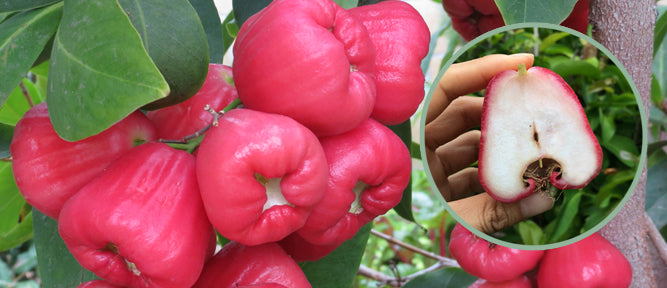
A few years ago I posted my first video on our Jambu tree on Youtube, and viewers' responses had exceeded my expectation. Many were surprised this tree can grow in the mainland US, so their interest in getting a hold of these seedlings became a question I've been asked often. Today I am very excited to tell you these darling seedlings will be available here! They were grown from the fruits of our tree. Not every fruit contains a seed so there's limited amount of seedlings available.
Jambu In My Childhood Memory
These fruits in the garden brought back memories of my childhood living in southeast Asia. It's hot most of the year in Vietnam so my dad often came home after work with papaya or jambu for me. He held the jambu between his palms, crossed his fingers and squeezed the fruit. A loud squish and a pop sound would follow then he gave me the two halves of the fruit he broke apart. It was sweet, crunchy and juicy, a taste I will not forget.
 Flowers of the Jambu
Flowers of the Jambu
After new leaves grow back in the spring, tiny clusters of flower buds start to form. When they bloom, they make the bees busy at work. Flowers can self pollinate to develop fruits.
How Jambu Taste
This is one of the most beautiful trees when it's covered with fruits. Fruits are crunchy, delicately sweetened, lightly fragrant like nectar, and just so refreshing! The texture of the exterior is like a pear, and the interior is like a watermelon. During the warmest time of the year, these fruits turn bright pink/red, tempting you to reach out to grab a few.
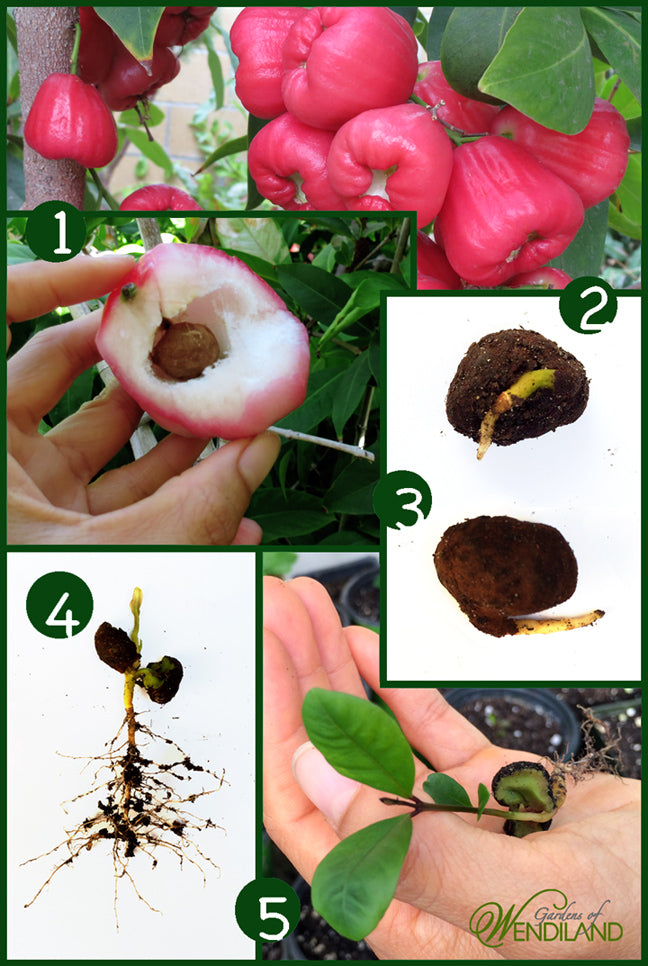
Who Can Grow Jambu?
Jambu is a sub tropical fruit tree that can adapt to places with a mild winter. Regions that freezes over in the winter can grow them in pots, and bring indoor during the colder period.
Where To Plant Jambu?
For places with mild winter, keep the seedling in a pot until it reaches about 1.5-2 ft tall before planting in the ground. It's best to plant the young tree in the ground in early spring so it has most of the year to adjust to its environment.
A seedling is more sensitive to the cold than a mature tree. Whether you are growing it in a pot or in the ground, find the warmest area where it gets the longest hours of sun. Full sun is best, or at least 6 or more hours of direct sun is preferred. The more sun it gets, the more flowers the tree will produce.
For regions that freezes over in the winter can grow them in pots, and bring indoor during the colder period. Keep tree in the warmest, brightest area in the room.
Water Requirements
The tree can endure dry soil for short period, but best to keep soil moist at all time. Leaves curling, folding inward is a sign for lack of water. Increase watering when the days get warmer. If there's not enough water given in the summer, the leaves may fold inward and get burned from the intense high sun. When the tree is flowering or setting fruits, increase watering slowly.
In the winter, cut back watering. This is time for the tree to rest since it's growth has slowed. If soil is too damp, it keeps the cold in the soil longer which can harm the roots.
Soil and Fertilizer Requirements
Grow Jambu in well drained soil to prevent waterlogging. Especially if you get winter rain, you want the water to drain quickly so roots are not sitting in cold water for long period.
Mix compost, warm casting, Perlite or sand, with native soil for growing it in the ground. If you are growing in a pot, organic potting mix for fruit trees can be purchased at any local nursery.
When the tree puts out new growth during spring, use an organic fertilizer that is higher in nitrogen to give it a boost. When flowers come, add organic fertilizer that is higher in phosphorus. You will see these indicated on the package of fertilizers so it's not absolutely necessary to remember these terms!
Aside from fertilizers, I like adding fresh compost such as vegetable scraps from the kitchen back in the soil. You can also make worm casting tea to water.
Protecting Jambu From The Cold
A young tree will need more cold protection than an established tree. Jambu begins to drop leaves as the temperature drops. By winter, my tree in Southern California loses about 30% more of less of its leaves. These fallen leaves make an excellent insulation covering the top of soil. Otherwise, mulch can be added to the soil top to protect the roots.
How Long Does It Take To Fruit Growing From Seed?
While every plant and its environment is different, I can only speak from my personal experience. Our tree was grown from seed, and it produced a few fruits by 3rd year. Each year after, the tree produced more fruits than the last!
Make Juice Without A Juicer August 15 2016
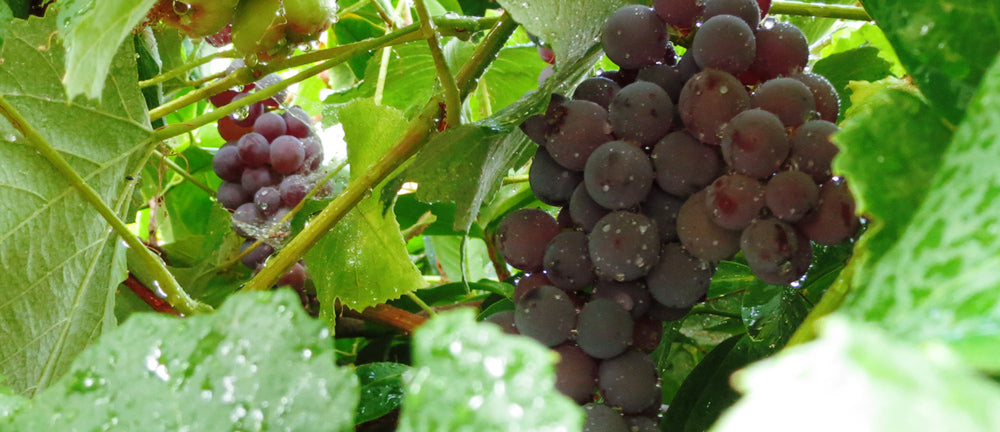 After a couple months of summer heat, grapes on our vine are ripening quickly. Warm days really made them taste sweeter than ever. At times I would fine many bunches ripening all at once. That's the thing with food -- if you don't enjoy them fast enough, they will end up in your compost.
After a couple months of summer heat, grapes on our vine are ripening quickly. Warm days really made them taste sweeter than ever. At times I would fine many bunches ripening all at once. That's the thing with food -- if you don't enjoy them fast enough, they will end up in your compost.
I supposed we can freeze the remaining grapes, but we really like to enjoy our fruits fresh for their maximum nutritional benefit. So these tiny, plump balls of sweetness ended up in our salads, baked goods, roasted dishes, and juices!
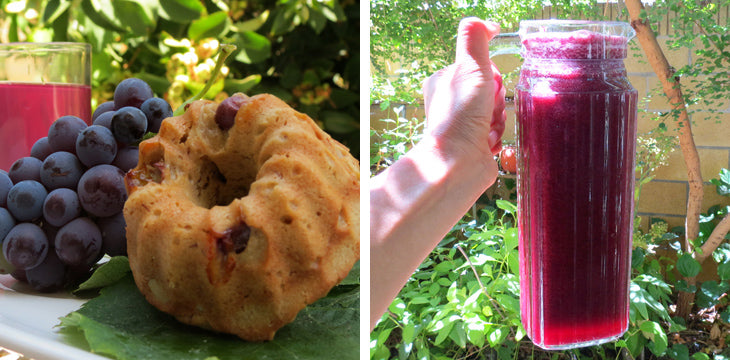
Over the weekend, our friend, who also has a grape vine, gifted a container of grapes to us! It's a variety with very hard seed inside so we decided to extract the juice rather than eating whole. Some of them were starting to ferment as well so we had to pick through and use them quickly.
When making juice, you will notice your fruits disappear in a snap! Since I don't own a juicer, I used a blender to extract it. You can do this with any juicy fruits such as oranges, plums, peaches, nectarines, or berries in a blender to make juice. See how I did it below!

How To Juice With Blender
Step 1: Wash and pick out the good grapes and put in the blender. I leave the bad ones for composting.
Step 2: Add 1/2-1 cup of water in the blender.
Step 3: Blend until fruits are broken in small pieces. The grapes my friend gifted had really hard seeds so I did not run the blender on high. It was only blending fast enough to break down the flesh.
Step 4: Place sifter over a container, pour liquid through a sifter to strain. Use a spoon or any kitchen utensil to press on the blended liquid as it would help the juice to pass the sifter.
Step 5: To make juice smoother, you can repeat straining then enjoy!
How To Bake With Grapes
Seedless grapes work best in baked goods since you can place them whole in the batter, otherwise slice grape in half to remove seed. Add fresh grapes in any muffin, cake, or bread recipes you like! The grapes will caramelize, and bring a sweet & tang twist to your baked goods.
Hopefully you can get creative with your fruits when there's abundance of them. Happy Gardening and Healthy Eating!
Healthy Diet 101 January 25 2016

From time to time I've been asked by my viewers, "How can I improve my health? What type of food should I eat?" First, I must tell you I am not a nutritionist. My knowledge on this topic was collected from years of research, personal experience, and keeping up on news in the health world. I helped my family and friends improve their health through food and supplements. Basically, if you eat the right type of food, it can do wonders for your health.
There's many types of diets out there, and they all may seem confusing to someone who is unfamiliar with this subject. That's why I rather focus on explaining about nutrition and food, not types of diets.
Our body is much like a car. It requires fuel to run. If you filled your car with low grade gas, it will run, but it won't run as smoothly, and efficiently. Whereas filling your car with premium gas, it will run smoother, have more power, and gets better mileage. It's the same with our body. If you eat food that is poor in nutrition, your body will function, but not at the maximum capacity. At times you may feel sluggish afterwards too. In contrast, if you had a well balanced, nutrient dense meal, you will have more energy, complexion will improve, your overall health will start feeling better.
Here's some healthy food suggestions I'd like to share with you. If you are new to this journey, below is a list of foods that I hope will inspire you to begin eating healthier.
| Food to Avoid |
Food to Eat |
Information | |
| Grains |
White bread, white pasta, white rice, white vermicelli |
Whole wheat, spelt, multi-grain, sprouted grains, brown rice, Basmati rice, millet, quinoa, barley, oat meal |
White flour aka All Purpose Flour, or Enriched Flour are mostly found in most food such as cookies, cakes, breads, pastas. White rice often are served in Asian dishes. These are low nutrition and high in starch, which turns into sugar in your body. Avoid intake of flour and rice that are white. Below "Food to Eat" section are grains that have more nutrition, fiber and won't spike blood sugar as quickly.
|
| Starch Vegetables | Russet potatoes, white corn |
Blue/purple potato, red potato, gold potato, sweet potato, pumpkin, squash |
All potatoes are high in carbohydrates, which turn into sugar for the body to use. When selecting starch vegetable, choose ones with deep pigment inside. These will offer more nutrients, minerals, and fiber. Pumpkin, squash, sweet potato have lower carbohydrates and higher nutrition. |
| Protein | Red meat: beef, farmed salmon, tuna |
Beans, organic soy, organic peanuts, nuts, plain yogurt, eggs, lean poultry, turkey, wild-caught salmon |
Limit your intake of red meat, it can led to many health problems. Generally, farmed salmon are raised with poor diet, lack of exercise, and live in contaminated water. Wild caught get more exercise, fresh diet, and fewer toxins from chemicals that some farms have. Farmed and wild salmon have levels of mercury, but not as high compared to larger fish such as Tuna and shark. Mercury can cause multiple issues such as nervous system, immune system, digestion, organs. Mercury does not leave the body once it enters so choose your fish carefully, and limit the amount you consume unless you know it is from a clean source.
|
| Leaf Greens | Sprouts, microgreens, Gynura Procumbens, Ashitaba, dandelion, kale, spinach, arugula |
When plants are at the sprouting or microgreen stage, they make all the nutrients in the seed available and easy for our body to absorb. That's why these tiny ones have many times more nutrients than full grown plants. Gynura Procumbens and Ashitaba are slowly getting recognized in America for their beneficial properties that many other vegetables do not have. Their properties can help improve health of blood sugar, blood pressure, cholesterol levels. Watch the video below to learn more about these amazing greens. When choosing leafy greens, eat the dark greens instead of ice berg lettuce. The green chlorophyll can boost your immunity, and promote overall wellness. |
|
| Sweeteners | corn syrup, beet sugar, agave, white sugar, artificial sweeteners | Honey, raw cane sugar, maple syrup | It's best to eat foods that are least processed or refined as possible. Honey, raw cane sugar, maple syrup have slightly more nutrients than processed sugars in the "Food to Avoid" list. However, if you are a diabetic, it's best to avoid cane sugar and maple syrup, and all processed sugars. |
| Oils | Corn oil, vegetable oil, canola oil, soy oil | Unrefined coconut oil, sunflower oil, safflower oil, olive oil, sesame oil | Limit consumption of fried foods. Occasionally lightly pan frying, roasting at 400F or lower are healthier alternative to deep frying. |
| Fats | Lard, shortening, hydrogenated oil, margarine | avocado, coconut meat, coconut cream, nuts, organic peanut butter, high quality butter, high quality fish oil |
Good fats can promote heart, brain, joint health, especially fats of avocado and coconuts. Bad fats can increase risk of cancer, cardiovascular disease, and other ailments. Choose butter from cows that's grass fed. Choose Omega 3 fish oil that has gone through process of eliminating mercury and other heavy metals. This supplement can promote healthy joints and heart. |
| Dressings | Thousand Island, Ranch, seasonings |
Italian dressing: Olive oil, raw vinegar. Creamy dressing: Tahini, olive oil, lemon juice Asian dressing: Sesame oil, organic soy sauce, honey, ginger (fresh or powder), garlic (minced or powder) |
Seasonings usually contain some form of MSG. Store bought salad dressings often contain preservatives, unhealthy oils, high about of salt or sugar. It's quick and easy to make your own to enjoy. |
| Beverages | Soda, diet soda | Mineral water, pure juices, smoothies, herbal tea: chamomile, lavender, rose hip, hibiscus, mint, dandelion root, rooibos, |
You can control what goes in your juice and smoothie if you make it. Add greens and fruits to make vitamin, mineral, antioxidant rich drink to enjoy. For diabetics, drink beverages that have more greens than fruits. Gynura procumbens, cucumbers, spinach are my favorite greens to add in smoothies. These greens have a neutral taste compared to other greens. Greens will give you more energy also. If purchasing your juice, always read ingredients list. Look for juice without sugar or corn syrup added. Certain juices such as pineapple, citrus, or berries goes well with mineral water. It's kind of like having a fruity soda! Some herbal teas some have calming effect, and can replenish your body with minerals. It's a great way to end the night since herbal tea does not contain caffeine. |
| Antioxidants | Processed food, junk food | Blue berry, cranberry, raspberry, acai, beets, dark leafy greens | Antioxidants have anti-aging effect. Each color is made up of a different kind of antioxidant property so it's good to include a rainbow of colors in your diet! The more vibrant your food looks, the more vibrant you will feel. |
| Snacks | Chips, candies, cookies | Nuts, pumpkin seeds, sunflower seeds, kale chips, dark chocolate with very low sugar | Nuts and seeds are very nutritious and contains healthy fats. You can roast nuts and seeds, add flavor and spices. You can blend cashews or almonds to make a dipping sauce. There's many simple recipes out there to explore. |
The chart above is a general guide. As you learn more about food, and how your body feels with certain kind -- slowly you can adjust your diet to better suit you. Be sure to consult with your physician, especially if you are on medications. Certain medications do not allow high intake of vitamin K, for example.
General rule of thumb is to include more raw foods in your diet. Start by eating a salad a day, or having a side of fresh, raw vegetables with your meals. These very small changes can make a big impact on your health.
Visit your local farmer's market, or grow your own for fresher, higher quality food. Support organically grown food as they are not grown with pesticide, chemicals, hormone and antiboitics.
♥ Learn About Gynura Procumbens ♥
♥ Blood Sugar Health Superfood Capsules ♥
http://wendiland.com/products/gynura-procumbens-supplement
♥ Learn More About Ashitaba ♥
♥ Learn More About Ashitaba ♥
Food to Inspire
♥1 Lotus root, bamboo shoot, sugar snap, purple sweet potato, carrot, mushroom, green onion cooked in low sodium organic soy sauce. Toasted sesame seeds and seaweed sprinkled over brown rice.
♥2 Lentil, carrot, gold potato cooked in water, unrefined coconut oil, curry powder. Raw dandelion cut and placed on top.
♥3 To make sauce: fresh basil, avocado, olive oil, fresh garlic, sea salt, lemon juice mixed in a food processor. Poured over pasta that's made with lentil.
♥4 Steamed egg: eggs, dairy or almond oil, small pinch of sea salt, toasted sesame oil, green onion.
There's no set rules when it comes to preparing food. Only stock up on healthy ingredients, and have fun in the kitchen. Once you get in the habit of cooking at home instead of ordering take outs, you will get to enjoy wholesome food regularly.
At times I came across someone asking why do I live this lifestyle, and I always say, "any health condition is stressful and painful to be in, and seeing your love ones go through it is just as difficult of a situation." That's why I encourage people around to maintain their health. Nutrient dense food will bring a quality of life to you and your love ones. I wish you the best of luck on this journey.
Easy Yeast Bread October 28 2015
 Many of us are obsessed with baked goods: cakes, muffins, bread just to name a few. A good piece of yeast bread is so satisfying when paired with your favorite dishes. That's why for many years I turned to the bakery for good quality bread. Before making my own bread I used to imagine how difficult it is to make. I couldn't understand the concept of turning this mosh that's made of flour and later they turn into this wonderful rustic shape. How do you turn flour into this mosh then it'll come out looking all rustic, crunchy and delicious? Or maybe I need a fancy commercial oven to make bread appear that way.
Many of us are obsessed with baked goods: cakes, muffins, bread just to name a few. A good piece of yeast bread is so satisfying when paired with your favorite dishes. That's why for many years I turned to the bakery for good quality bread. Before making my own bread I used to imagine how difficult it is to make. I couldn't understand the concept of turning this mosh that's made of flour and later they turn into this wonderful rustic shape. How do you turn flour into this mosh then it'll come out looking all rustic, crunchy and delicious? Or maybe I need a fancy commercial oven to make bread appear that way.
A few years ago I decided to attempt making my own bread because organic whole wheat bread is almost impossible to find near me. I pulled out recipes and attempted to bake, and it sure wasn't successful. That's when I turned to baking soda breads using baking soda as the leavening agent. Soda bread is tasty, but it's not like a toasty piece of yeast bread.
Recently I decided to give yeast bread another try. After multiple experiments later, I learned how to work with whole wheat, spelt and all purpose flour. Turns out most recipes available are for baking with all purpose white flour. Whole wheat requires more water and yeast for it to raise. Spelt requires the least amount of water compared to others. Spelt is an ancient grain. Spelt and whole wheat offer more nutritious than all purpose white flour, but I find that spelt is easier to work with especially if you make bread that requires kneading. Don't worry though, in this blog and video I will keep it simple. There will be no kneading involved.
Finally, it is very important that your yeast is alive or your dough isn't going to rise! To properly store yeast, the packet needs to be air sealed, or release all oxygen (as much as possible) before storing. For longer shelf life, you can store it in refrigerator or the freezer.
Ways To Bake
If you want a rustic thick, crunchy crust use a cast iron or clay topf with a lid. Using an oven safe pot that can withstand 500F would be fine too, but it won't create the crust the same way.
You can use a pizza stone, pan, or skillet, and bake at 425-450F instead of 500F. You will need to allow dough to rise again after shaping it. This will create a thinner crust. It's all the matter of preference!
Baking without a lid
If you choose to bake without a lid -- place the dough that you already made into a shape you want on a sheet of parchment paper. Or, if you have access to banana leaves that's what I use. You can find this in the frozen section at Mexican and Asian markets. You can to allow 1/2-1 hour for the dough to rise on the parchment paper. While waiting for dough to rise preheat the oven to 425 or 450 F with a pan inside. Once dough doubles its size, take a knife and score a "+" on top. Finally, carefully pickup the parchment paper with the dough to place on the pan, and let it bake about 25-35 minutes. To ensure the bread is cooked, poke the interior with a stick. If the stick comes out clean the bread is ready!
Baking Directly On A Pan
This method requires the least tools. No parchment paper, just flour the pan then place the dough directly on top. Allow 1/2-1 hour for dough to rise. Preheat oven to 425-450F. Once dough doubles its size place the pan in the oven. Let it bake for 25-35 minutes.
You don't need fancy kitchen supplies to make a good loaf of bread. Using any methods above would create a great loaf, just that crust thickness will vary.
Hope you enjoy the simple recipe. Have fun, and good luck!
♥RECIPES♥
Spelt Flour Bread:
3 cups flour
1-1 1/8 cup lukewarm water (add more if needed)
1 teaspoon dry yeast
Whole Wheat Flour Bread:
3 cups flour
2-2 1/4 cup lukewarm water (add more if needed)
1 tablespoon dry yeast
All Purpose Flour Bread:
3 cups flour
1 1/2 cup water
1 teaspoon yeast
♥Watch the video to see how easy it is to bake bread!♥
Reishi Mushroom (Ling Chi or Ling Zhi) January 05 2015

Reishi is the Japanese's name. It means 10,000 year mushroom! In Chinese, this woody mushroom is called Ling Chi or Ling Zhi, it means mushroom of immortality! This mushroom was so precious that only the kings and queens could afford it. Their servants had to travel hundreds, or even thousands of miles and high up the mountain to harvest from the wild. It's only very recent that Reishi mushrooms were cultivated.
This is a powerful, medicinal mushroom that helps to cleanse and detoxify our body. The high level of antioxidants in the Reishi can help strengthen our immune system and reduce inflammation. Reishi can also help strengthen the function of our organs, relieve arthritis pain, suppress or prevent growth of tumors, even help with candida overgrowth.
To make the tea
Each mushroom can make approximately one gallon of medicinal tea. Bowl a pot of filtered water, or the purest form of water you find, slice it in small pieces and place in water. Bring water to boil then turn heat to low and simmer for 30min or up to 2 hours with the lid on. The longer you steep the tea, the richer the flavor will be. You can reuse Reishi to make the tea two more times after. Each time the flavor will be less intense than the previous. Finally you can compost it.
Tea is best to drink warm. The rest you can store in the refrigerator up to 1 week. I hope you get a chance to try this wonderful, medicinal tea!
Click here for fresh Reishi Mushroom!
Watch how I made Reishi tea!
Spontaneous Hike in Mount Baldy August 17 2014


 Again, we went on another spontaneous hiking trip. We didn't decide to go hiking until the very day. I checked the weather and it showed that it's going to be 90F in the area we'd be hiking so it got me a little worried about the heat. Luckily there was a nice breeze during our long day hike since it's at a higher altitude.
Again, we went on another spontaneous hiking trip. We didn't decide to go hiking until the very day. I checked the weather and it showed that it's going to be 90F in the area we'd be hiking so it got me a little worried about the heat. Luckily there was a nice breeze during our long day hike since it's at a higher altitude.

 Before leaving home, we packed our backpacks full of water, jambu (wax apples), and peanut butter sandwich with passion fruit and Gynura Procumbens inside. Nuts and a few power/protein bars were also in the backpacks. The jambu were so refreshing, and the Gynura Procumbens leaves in our sandwich gave us a little boost of energy to keep going. Passion fruit made a really good "jelly" in the peanut butter sandwich. The weight in our backpacks definitely had made our hike more challenging, especially the higher we climb, and the oxygen is reduced, but we are so thankful to have all the food with us or we wouldn't have made it to the top.
Before leaving home, we packed our backpacks full of water, jambu (wax apples), and peanut butter sandwich with passion fruit and Gynura Procumbens inside. Nuts and a few power/protein bars were also in the backpacks. The jambu were so refreshing, and the Gynura Procumbens leaves in our sandwich gave us a little boost of energy to keep going. Passion fruit made a really good "jelly" in the peanut butter sandwich. The weight in our backpacks definitely had made our hike more challenging, especially the higher we climb, and the oxygen is reduced, but we are so thankful to have all the food with us or we wouldn't have made it to the top.

 After a very long, tiring day we finally made it to the top! San Antonio "Mt Baldy" Summit at 10,064 Ft, marks the highest point of Los Angeles County. Although by my very last mile I was traveling just 1 or 2 mph ( I know, that's pretty ridiculous ), it sure felt so good to finally made it. The view was spectacular. Mountains in front of us looked like a giant watercolor painting. It was breath taking.
After a very long, tiring day we finally made it to the top! San Antonio "Mt Baldy" Summit at 10,064 Ft, marks the highest point of Los Angeles County. Although by my very last mile I was traveling just 1 or 2 mph ( I know, that's pretty ridiculous ), it sure felt so good to finally made it. The view was spectacular. Mountains in front of us looked like a giant watercolor painting. It was breath taking.
The Perfect Catch June 24 2014
 Ever since I planted these Hairy Balls plants (AKA: Milk Weed. Scientific name: Gomphocarpus physocarpus) about two years ago, they have been attracting Monarch butterflies. I These beautiful little creatures are often seen flying in and out of the garden especially in spring and summer. This morning I was fortunate enough to catch one that just hatched. I'm still trying to catch one in the process of hatching, but for now, hope you enjoy this photo I captured.
Ever since I planted these Hairy Balls plants (AKA: Milk Weed. Scientific name: Gomphocarpus physocarpus) about two years ago, they have been attracting Monarch butterflies. I These beautiful little creatures are often seen flying in and out of the garden especially in spring and summer. This morning I was fortunate enough to catch one that just hatched. I'm still trying to catch one in the process of hatching, but for now, hope you enjoy this photo I captured.
You can also watch the video I did on these butterflies:
Gynura Procumbens Vs Gynura Crepioides June 02 2014
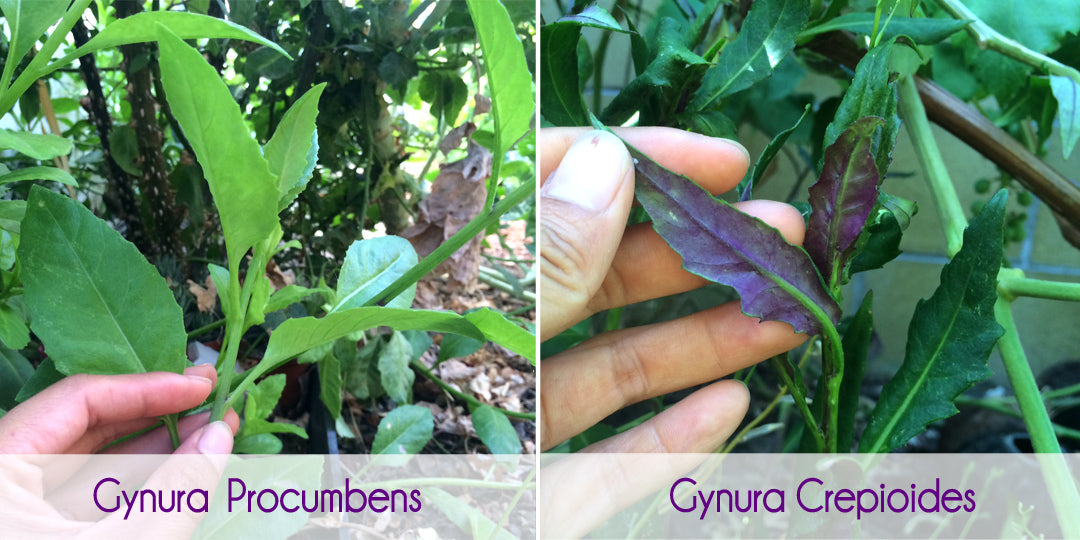 Some people have been confused about Gynura Procumbens and Gynura Crepioides so I decided to explain the difference and similarities between the two.
Some people have been confused about Gynura Procumbens and Gynura Crepioides so I decided to explain the difference and similarities between the two.
Similarities:
- Both types of vegetables are grown in a similar way. They both like partial sun/shade and can withstand full sun as long as the soil stays moist.
- They have similar tastes, but the Gynura Crepioides has a slight bitterness.
- They develop slight purple specks on the green stem when it's more mature.
Differences:
- Most research and reports from people about the benefits for diabetes, high blood pressure, high cholesterol is for the Gynura Procumbens.
- Leaves of Gynura Procumbens are green on both sides.
- Leaves of Gynura Crepioides are green on top side and bottom side is purple.
- Shape of the Gynura Crepioides leaves are more narrow and is saw-like where as Gynura Procumbens are more smooth, and the width of the leaves are wider.
I personally prefer the taste of the Gynura Procumbens over the other. The taste of Gynura Procumbens is more pleasant and easy to acquire. Here is a video about this vegetable if you are interested.
Garden of Grapes May 07 2014

 This is the first year ever to have grapes in the garden! From the moment I was able to identify the silver little things on tips of the vines to be flower buds I was full of joy. It's been about 1.5-2 months since the little buds came and now the largest grapes on the vine are starting to turn purple. I find this to be the prettiest stage of the grapes because that hint of blue is starting to show through the green, creating such a frosty appearance.
This is the first year ever to have grapes in the garden! From the moment I was able to identify the silver little things on tips of the vines to be flower buds I was full of joy. It's been about 1.5-2 months since the little buds came and now the largest grapes on the vine are starting to turn purple. I find this to be the prettiest stage of the grapes because that hint of blue is starting to show through the green, creating such a frosty appearance.
There are quite a few clusters of this Japanese purple variety on the vine so in a couple more months we would have so much grapes to share with family and friends. Hopefully they will continue to do well and grow into beautiful clusters of purple jewels.
It occurred to me today that we can use these leaves as food too! Many Mediterranean dishes use them to wrap food. You can eat them raw, baked, steamed, however you like! It is best to pick the young leaves so they won't be so tough. I'm really looking forward to using these leaves.
The first thing I made use of the leaves were to place my chocolate pudding on top. I just love how natural it displays this little piece of heaven. :)
Surprise Hike at Cleveland National Forest May 01 2014


Yesterday the sky in L.A. was filled with smoke. Everyday this week has been dry, high winds and reached 97F! It's a magnet for fire. Surely there was 3 fires in and around LA. We decided to do a staycation for some fresh air. This was a completely spontaneous, unplanned trip we made. Just packed our backpacks with loads of water and power bars and headed 2.5 hours south.
The mountains you see in the photo was in East San Diego County. I was surprised to see so much green in this hot weather. Usually in So Cal, greenery only last until early spring. The mountains were so beautiful, much like a landscape painting showing great depth. We hiked and sometimes had to climb over large rocks to get to where we wanted. It was about a total of 4-6 miles we hiked.
The goal of this trip was to find the waterfall, but Cleveland National Forest did not provide much signs at all. We ended up going off trail and climbed some rocks then it led us to the cliff with no waterfall. That's ok, we figured we'll just take out our lunch and enjoy the view.
On our way back we finally saw the waterfall we were looking for; thus, decided to go see it. We jogged as fast as we could, trying to beat the sunset getting to the waterfall. Finally, we made it close enough to see it and stopped there to enjoy for a bit. It was about 7:30 pm now, and it gets dark quicker in the mountains so we headed back to the car.
By 11 pm we made it home. This all happened like a dream to me. In the morning I was home responding to emails then by 5 pm we were sitting on a cliff overlooking the mountain range having lunch. Just a few hours after that we were home with Lotus (my dog).
Avocado Health Benefits April 27 2014


I came across a Giant Avocado at the market the other day. There were a pile of regular size Hass, but 2 out of the pile stood out to me. They were these giant avocados. Since I have never had it, it was a must try for me.
Although avocado has such a rich texture, but the rich fats are actually good for you. Avocado contains vitamin B6, E, and folic acid, which can help regulate homocysteine levels, preventing heart disease. It can also regulate your blood sugar, blood pressure, promote eye health, anti-aging properties. Now we know that the creamy good fats in avocado is beneficial for us, we can enjoy it moderately without having guilt.
I love using avocado in my smoothies, milkshakes, salads, and make guacamole of course! I have an Out of this World recipe for a vegan chocolate pudding / fudge recipe made with avocado if you are adventurous. Click here for the recipe!
As for the taste of this giant avocado, it definitely looked better than it taste in my opinion. It has a much more sweet flavor, but not as creamy and rich like regular avocado. Maybe if it was grown in better soil, it'll improve the flavor, but for this taste test, it's not my favorite kind. I have not researched what kind of avocado this is, if you recognize this type, please let me know!
Natural Coloring -- Purple Tortilla! April 25 2014




I'm constantly on a quest for natural ingredients to use when I'm making food. Here you see some purple juice, purple dough, purple tortilla! The purple juice came from a plant called Magenta Plant (Peristrophe roxburghiana)! You must think why is this plant called magenta when the leaves are green, or where does the purple come from!?
The Magenta Plant is definitely one of my favorite plants to grow because of its uniqueness -- though the leaves are green, but once boiled in some water the juice of the leaves will turn purple! The Vietnamese have been using this plant to dye their sweet rice purple for many generations.
Here I've given a try to use the juice in flour instead of rice, and it made my dough lavender. Such a pretty, soft color! I think I will be using a lot more of this plant in the near future to create some fun dishes!
- Page 1 of 2
- Next
